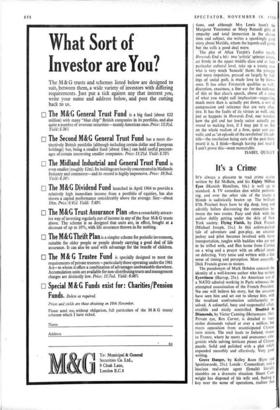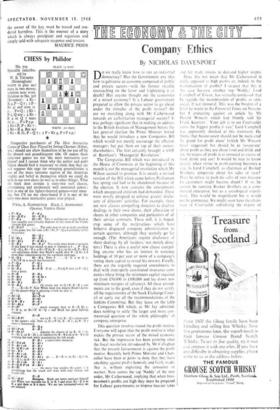tions, and although Mrs Lewis hasn't the Margaret Yourcenar or
Mary Renault gifts of empathy and total immersion in the chosen time and subject, she writes a spankingly good story about Matilda, whom the legends cal] gentle but she calls a good deal more.
The M & G trusts and schemes listed below are designed to suit, between them, a wide variety of investors with differing requirements. Just put a tick against any that interest you, write your name and address below, and post the cutting back to us.
❑ The M&G General Trust Fund is a big fund (about £22 million) with many "blue chip" British companies in its portfolio, and also quite a number of overseas securities—mainly American ones. Price: 131314. Yield: 5.76% ❑ The Second M&G General Trust Fund has a more dis- tinctively British portfolio (although including certain dollar and European holdings) but, being a smaller fund (about £4m.) can hold useful percent- ages of certain interesting smaller companies. Price: 11121d. Yield: 5.75% ❑ The Midland Industrial and General Trust Fund is even smaller (roughly £2m). Its holdings are heavily concentrated in Midlands Industry and commerce—and its record is highly impressive. Price: 10/9xd. Yield: 6.38% ❑ The M&G Dividend Fund launched in April 1964 to provide a relatively high immediate income from a portfolio of equities, has also shown a capital performance considerably above the average. Size —about £8m. Price: 9/41-d. Yield: 7.49% ❑ The M & G Trust Assurance Plan offers a remarkably attract- ive way of investing regularly out of income in any of the four M & G trusts above. The scheme is so designed that units are, in effect, bought at a discount of up to 10%, with life assurance thrown in for nothing.
❑ The M & G Thrift Plan is a simpler scheme for periodic investment, suitable for older people or people already carrying a good deal of life assurance. It can also be used with advantage for the benefit of children.
❑ The M& G Trustee Fund is specially designed to meet the requirements of private trustees — particularly those operating under the 1961 Act—to whom it offers a combination of advantages unobtainable elsewhere. Accumulation units are available for non-distributing trusts and management charges are distinctly low. Price: 11 I7xd. Yield: 6.06%
❑ Special M & G Funds exist for : Charities/Pension
Please send me, without obligation, full particulars of the M & G trusts/ schemes which I have ticked.
SI' To: Municipal & General Securities Co. Ltd., 9 Cloak Lane, London E.C.4 The plot of Allan Turpin's Ladies recalls Howards End a bit: two 'artistic' spinster sisters, set firmly in the upper middle class and at their • particular cultural level, take up a young man who is very much 'beneath' them; the younger and more impulsive, pressed on largely by feel- ings of social guilt, is made love to by him— once. It has other Forsterish qualities as well: discretion, exactness, a fine ear for the cadences of this or that class's speech, above all a sense of what you might call implication—suggesting much more than is actually put down, a sort of compression and reticence that are very effec- tive. It has the faults of its virtues as well, and, just as happens in Howards End, one wonders how the girl and her lowly suitor actually got round to making love, if I may put it so. But
on the whole realism of a firm, quiet sort pre- vails; and as 'an episode of the revolution' (its sub-
title—the revolution being ours of the past thirty years) it is, I think—though having just read it I can't prove this—even memorable.
ISABEL QUIG LY
It's a Crime
doted harmless. This is the essence of a story
simply told with adequate suspense and tension.
MAURICE PRIOR
CHESS by Philidor
No. 309
Specially contribu- ted by W. B. TRUMPER
(Birmingham) WHITE to play and mate in two moves; solution next week. Solution to No. 308 (Kraemer) : t Kt - K4,13-Q7i 2P - Kt 41 and now (a' 2...P=Q; 3Kt- B5,QanYi 4Kt- R 4 or Q 7 mate (b)2...PxPe.p.: 3 Kt x P, P- Kt 7 ; 4 Kt – B 4. But not Kt 6?,P–Q 7; Prospective purchasers of The Most instructive Games of Chess Ever Played by Irving Chemev (Faber, 3os.) should not allow themselves to be too put off by the absurd and grandiloquent title. Of course these sixty-two games are not 'the most instructive ever played' and I cannot think why the author and pub= fishers should find it necessary to claim that they are —I suppose this urge for sweeping generalisation is one of the more tiresome aspects of the American vitality and belief in themselves which we could do with in our own chess (as well as in other things). What the book does contain is sixty-two well chosen, entertaining and moderately well annotated games ; here is one of the lighter-hearted games—very amus :ng, but I'll eat my chess-board if it is one of the sixty-two most instructive games ever played. BLACK (9 men)
wear rE fro men) P Kt 4, P x P e.p.!































 Previous page
Previous page